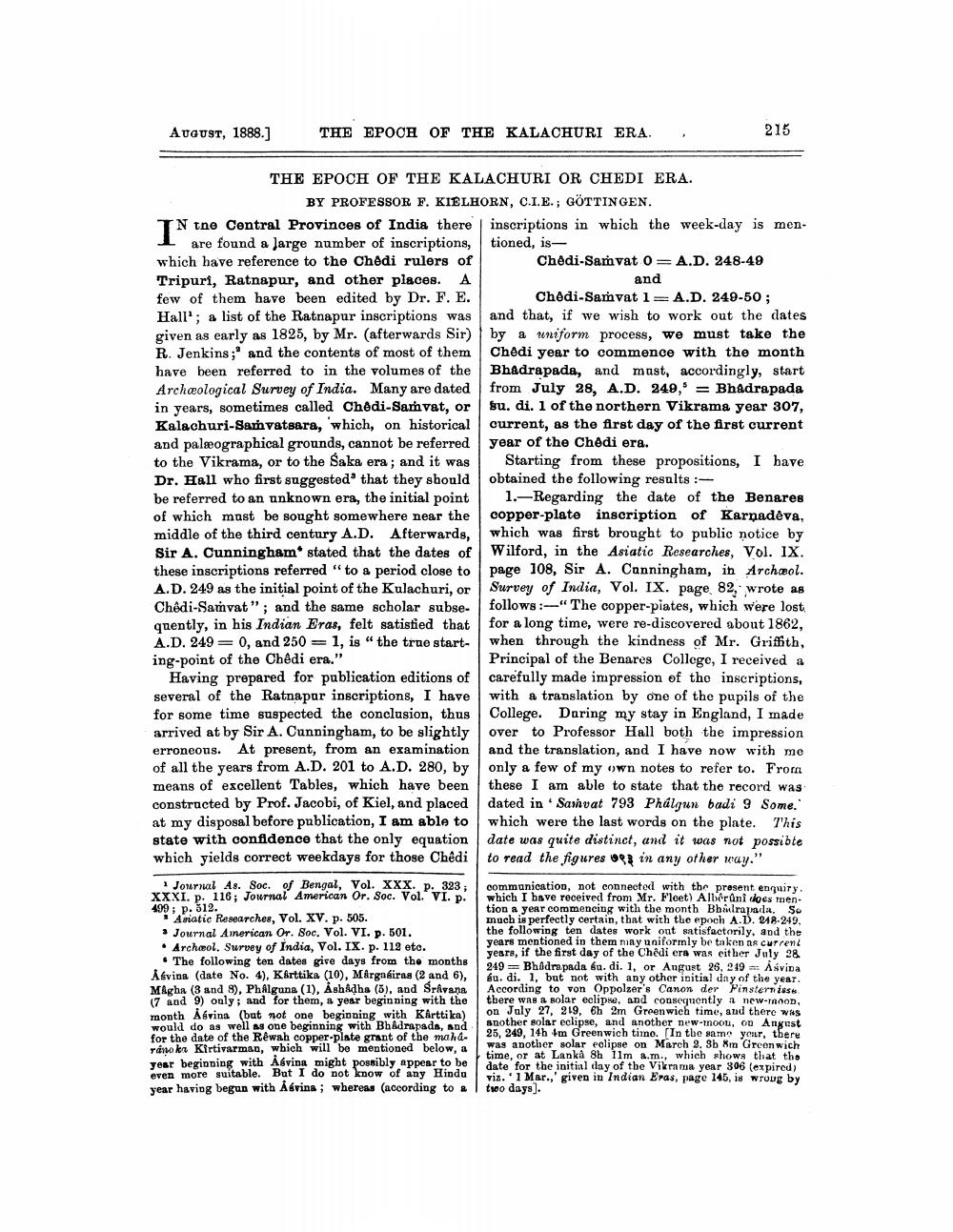________________
AUGUST, 1888.]
THE EPOCH OF THE KALACHURI ERA.
215
THE EPOCH OF THE KALACHURI OR CHEDI ERA.
BY PROFESSOR F. KIELHORN, C.I.E.; GÖTTINGEN. TN tne Central Provinces of India there inscriptions in which the week-day is men
1 are found a large number of inscriptions, tioned, iswhich have reference to the Chedi rulers of Chedi-Samvat 0= A.D. 248-49 Tripuri, Ratnapur, and other places. A
and few of them have been edited by Dr. F. E. Chedi-Samvat 1= A.D. 249-50; Hall'; a list of the Ratnapur inscriptions was and that, if we wish to work out the dates given as early as 1825, by Mr. (afterwards Sir) by a uniform process, we must take the R. Jenkins;' and the contents of most of them Chedi year to commence with the month have been referred to in the volumes of the Bhadrapada, and mast, accordingly, start Archæological Survey of India. Many are dated from July 28, A.D. 249, = Bhadrapada in years, sometimes called Chedi-Samvat, or su. di. 1 of the northern Vikrama year 307, Kalachuri-Samvatsara, which, on historical current, as the first day of the first current and paleographical grounds, cannot be referred year of the Chedi era. to the Vikrama, or to the Saka era, and it was Starting from these propositions, I have Dr. Hall who first suggested that they should obtained the following results :be referred to an unknown era, the initial point 1.-Regarding the date of the Benares of which must be sought somewhere near the copper-plate inscription of Karnadeva, middle of the third century A.D. Afterwards, which was first brought to public notice by Sir A. Cunningham stated that the dates of Wilford, in the Asiatic Researches, Vol. IX. these inscriptions referred "to a period close to page 108, Sir A. Cunningham, in Archæol. A.D. 249 as the initial point of the Kulachuri, or Survey of India, Vol. IX. page 82, wrote as Chedi-Samvat"; and the same scholar subse follows:-"The copper-piates, which were lost quently, in his Indian Eras, felt satisfied that for a long time, were re-discovered about 1862, A.D. 249 = 0, and 250 = 1, is "the true start- when through the kindness of Mr. Griffith, ing-point of the Chêdi era."
Principal of the Benares College, I received a Having prepared for publication editions of carefully made impression of tho inscriptions, several of the Ratnapar inscriptions, I have with a translation by one of the pupils of the for some time suspected the conclusion, thus College. During my stay in England, I made arrived at by Sir A. Cunningham, to be slightly over to Professor Hall both the impression erroneons. At present, from an examination and the translation, and I have now with mo of all the years from A.D. 201 to A.D. 280, by only a few of my own notes to refer to. Frora means of excellent Tables, which have been these I am able to state that the record was constructed by Prof. Jacobi, of Kiel, and placed dated in Samvat 793 Phálgun badi 9 Some. at my disposal before publication, I am able to which were the last words on the plate. This state with confidence that the only equation date was quite distinct, and it was not possible which yields correct weekdays for those Chedi to read the figures in any other way."
en
formistisfech 4.3
Journal As. Soc. of Bengal, Vol. XXX. p. 323; communication, not connected with the present enquiry. XXXI. p. 116; Journal American Or. Soc. Vol. VI. p. which I have received from Mr. Fleet) Alberuni does men499 ; p. 512.
tion a year commencing with the month Bintrapada. So • Asiatic Researches, Vol. XV. p. 505.
much is perfectly certain, that with the epoch A.D. 18-249, * Journal American Or. Soc. Vol. VI. p. 501.
the following ten dates work ont satisfactorily, and the Archeol. Survey of India, Vol. IX. p. 112 etc.
years mentioned in them may uniformly be taken as current
years, if the first day of the Chêdi era was either July 28. • The following ten dates give days from the months
249 = BhOdra pada ku. di. 1, or Angust 26, 219 Asvida Alvina (date No. 4), Kerttika (10), Mårgasiras (2 and 6), éu. di. 1, but not with any other initial day of the year. MAgha (3 and 8), PhAlguna (1), ÅshAdha (5), and Srivana According to von Oppolzer's Canon der Pinsternisse 17 and 9) only; and for them, a year beginning with the there was a solar eclipse, and consequently a new-rnoon, month Abvina (but not one beginning with Karttika)
on July 27, 219, 6h 2m Greenwich time, and there was would do as well as one beginning with Bhadrapada, and
another solar eclipse, and another new-noon, On Angust for the date of the Rêwah copper-plate grant of the mana
25, 249, 14h im Greenwich time. In the samo your, there ránok Kirtivarman, which will be mentioned below, a
was another solar eclipse on March 2. Sb 8m Greenwich
time, or at Lanká 8h Ilm a.m., which shows that tho year beginning with Alvina might possibly appear to be date for the initial day of the Vikenma year 306 (expired) even more suitable. But I do not know of any Hindu vix. 1 Mar.,' given in Indian Eras, page 146, is wroug by year having begun with Alvins; whereas (according to altro days).




